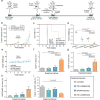In vivo gene editing of T-cells in lymph nodes for enhanced cancer immunotherapy
- PMID: 39587061
- PMCID: PMC11589603
- DOI: 10.1038/s41467-024-54292-0
In vivo gene editing of T-cells in lymph nodes for enhanced cancer immunotherapy
Abstract
Immune checkpoint blockade (ICB) therapy, while promising for cancer treatment, faces challenges like unexpected side effects and limited objective responses. Here, we develop an in vivo gene-editing strategy for improving ICB cancer therapy in a lastingly effective manner. The approach uses a conductive hydrogel-based electroporation system to enable nucleofection of programmed cell death protein 1 (PD1) targeted CRISPR-Cas9 DNAs into T-cells directly within the lymph nodes, and subsequently produces PD1-deficient T-cells to combat tumor growth, metastasis and recurrence in different melanoma models in mice. Following in vivo gene editing, animals show enhanced cellular and humoral immune responses along with multi-fold increases of effector T-cells infiltration to the solid tumors, preventing tumor recurrence and prolonging their survival. These findings provide a proof-of-concept for direct in vivo T-cell engineering via localized gene-editing for enhanced cancer immunotherapy, and also unlock the possibilities of using this method to treat more complex human diseases.
© 2024. The Author(s).
Conflict of interest statement
Competing interests: The authors declare the following competing interests: P.S., J.Q., Y.W., and X.H. are listed as inventors on a patent application, titled “Micro-electroporation based drug delivery system, methods for use and fabrication thereof” (US Priority No. 17/804,118), filed by the City University of Hong Kong. The other authors declare no competing interests.
Figures






References
-
- Wang, C. et al. In situ activation of platelets with checkpoint inhibitors for post-surgical cancer immunotherapy. Nat. Biomed. Eng. 1, 0011 (2017).
-
- Conniot, J. et al. Immunization with mannosylated nanovaccines and inhibition of the immune-suppressing microenvironment sensitizes melanoma to immune checkpoint modulators. Nat. Nanotechnol.14, 891–901 (2019). - PubMed
-
- Sharma, P. & Allison, J. P. The future of immune checkpoint therapy. Science348, 56–61 (2015). - PubMed
Publication types
MeSH terms
Substances
LinkOut - more resources
Full Text Sources
Research Materials

